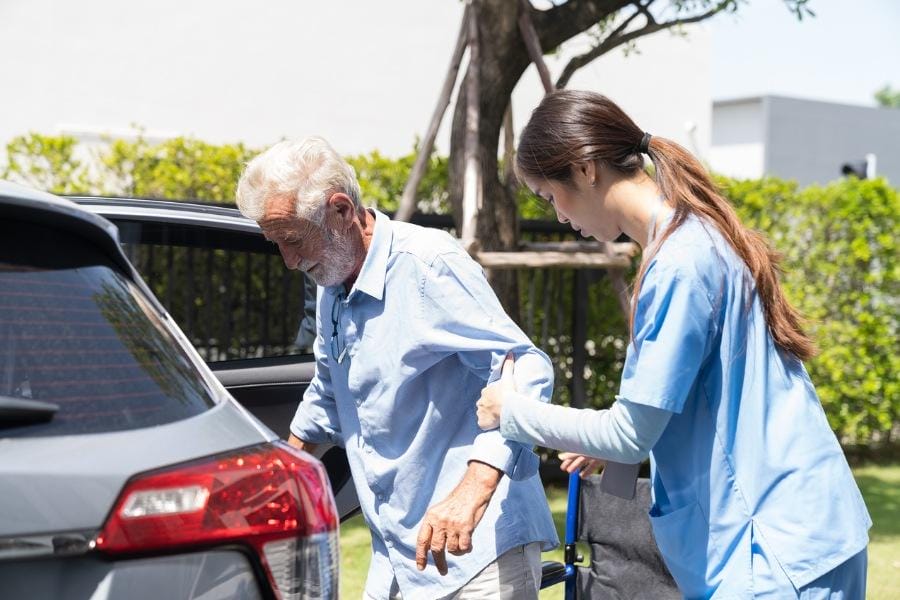Can You Drive with Parkinson’s Disease?
We understand one of your biggest concerns might be: “Can you drive with Parkinson’s disease?“
The answer isn’t black and white, and if you’re asking this question, you’re already taking an important step in prioritizing both your independence and safety.
Here’s the encouraging news: In the early stages of Parkinson’s, many people continue driving safely and independently.
However, let’s be honest – Parkinson’s symptoms can make driving more challenging over time.
It’s like learning to write with your non-dominant hand; your body needs to adapt to new ways of doing familiar tasks. Your reaction time, muscle control, and movement patterns might change, and that’s completely normal with this condition.
What matters most is recognizing your unique journey with Parkinson’s. Some days might feel better than others, and that’s okay.
Think of it as a personal conversation between you, your healthcare team, and your loved ones about what feels safe and comfortable for you behind the wheel.
Remember, choosing to limit or stop driving isn’t giving up – it’s taking control.
Whether it’s relying on family, using ride-sharing services, or exploring community transportation options, there are many ways to stay connected and independent while prioritizing your well-being.
Want to learn more about driving safely with Parkinson’s? Let’s explore your options together.
Key Takeaways
- Parkinson’s can impact driving ability over time.
- Safety assessments are crucial for maintaining independence.
- Alternative transportation options are available for support.
How Does Parkinson’s Disease Affect My Driving?

Parkinson’s disease is a progressive movement disorder that can significantly affect an individual’s ability to drive.
Key symptoms, such as tremors and cognitive changes, play important roles in this context.
It is crucial to understand how these symptoms and medication side effects influence safe driving.
PD Symptoms Relevant to Driving
While it may not be a complex task, several motor symptoms can impact the ability to drive safely.
Tremors, which cause shaking in the hands or other parts of the body, may affect steering and gear changes.
Bradykinesia, or slowness of movement, can delay reaction times during critical driving situations.
Rigidity and stiffness can make it hard to turn the head or check mirrors properly.
Coordination and motor skills are often compromised, causing difficulties in controlling the vehicle.
Additionally, cognitive impairment can lead to issues with focus and attention, making it hard to respond to traffic signals or other drivers.
Vision changes may also make it difficult to judge distances and speeds accurately.
Summary: PD symptoms may affect your driving by making the following difficult:
- Reacting to road hazards
- Effectively pushing the gas pedal or brake quickly
- Turning the steering wheel
- Safe night driving due to vision changes
Medication Side Effects and Driving
While medications can help manage Parkinson’s symptoms and overall quality of life, they can also cause side effects that affect driving abilities.
Drowsiness is a common side effect of many Parkinson’s medications, leading to reduced alertness during driving.
Some medications may cause dizziness or fluctuations in cognitive function, such as memory loss, further impairing driving skills.
Cognitive changes can include problems with memory and decision-making, which are crucial when navigating the roads.
It’s essential for individuals taking these medications to discuss potential side effects with healthcare providers.
They should regularly assess their driving capabilities to ensure they remain safe on the road.
Tips for Driving with Parkinson’s Disease
Here are some best practices and suggestions when it comes to driving with Parkinson’s disease.
- Use a GPS system to navigate even when traveling a familiar route
- Avoid driving when tremors or other symptoms are severe
- Consider installing unique and adaptive equipment to assist in driving, such as special steering wheels
- When possible stick to driving during the day for the best visability
Evaluating Driving Safety for Individuals with Parkinson’s

Determining if someone with Parkinson’s can drive safely involves a careful review of their skills and reactions.
Honestly, a comprehensive driving evaluation is completely necessary.
Professional assessments and ongoing evaluations are crucial in making informed decisions.
Professional Driving Assessments
Professional driving assessments are essential for individuals with Parkinson’s. These evaluations are typically conducted by a Certified Driving Rehabilitation Specialist or an Occupational Therapist.
They review a person’s medical history and current symptoms to gauge driving safety.
The evaluation may include a driving test in various road conditions.
A driving simulator can also be used to assess how well individuals handle different scenarios. Factors such as reaction time, cognitive function, and depth perception are critical in these assessments.
Results guide decisions about whether someone should continue driving or if adjustments are needed for safe driving habits.
Assessing Driving Skills and Reaction Times
It is important to evaluate an individual’s driving skills regularly. Parkinson’s can affect motor control and cognitive function, which directly impacts driving ability. Memory problems and slower reaction times can increase the risk of accidents.
During driving assessments, professionals check specific skills like turning, braking, and lane changes.
They also observe how well the individual can process information and respond to changing traffic situations. Identifying these skills ensures that individuals with Parkinson’s can make safe driving choices.
Regular evaluations help monitor any changes in driving skills, ensuring safety for the individual and others on the road.
Alternative Transportation Options and Support Systems
For individuals with Parkinson’s Disease, finding safe ways to travel is essential.
It’s important to outline real-life driving outcomes and scenarios.
Several options exist, including accessible transportation services and community support systems that can make mobility easier.
Utilizing Accessible Transportation Services

Accessible transportation services offer valuable options for those who can no longer drive safely.
These services often include public transportation, paratransit services, and rideshare options.
- Public Transportation: Many cities have buses and trains equipped with features like ramps and priority seating. They often provide discounts for seniors or individuals with disabilities.
- Paratransit Services: These services are specifically designed for people with mobility challenges. They offer door-to-door transportation, which can be more convenient. Users may need to apply to be eligible, and individualized services can include shuttles that accommodate wheelchairs.
- Taxis and Rideshare Services: Standard taxis and rideshare options like Uber or Lyft may have drivers trained to assist those with disabilities. Some services offer vehicles that accommodate wheelchairs.
- Easterseals Project ACTION (Accessible Community Transportation In Our Nation): 800-659-6428
- Disabled American Veterans (DAV): Find your nearest DAV driving program
Transportation experts or driving rehabilitation specialists can help assess the best transportation options based on individual needs.
Finding Community and Support
Community support plays a crucial role in maintaining independence. Local organizations often provide resources to help those with PD navigate transportation challenges.
- Support Groups: Joining a local Parkinson’s support group can connect individuals to others facing similar issues. They can share experiences and recommendations for accessible transportation.
- Eldercare Locator: This nationwide service helps individuals find local transportation services and support programs.
- Care Partners: Family members or friends can help coordinate transportation plans. Their involvement can ease feelings of disorientation often experienced by those with PD symptoms.
- Private Nursing Care: In-home nurses can help care for individuals with PD, provide medical care that caregivers cannot, and even drive Parkinson’s patients to appointments and other destinations. Insurance coverage is not a concern with private nurses.
By utilizing these resources, individuals can enhance their mobility and maintain independence while managing Parkinson’s Disease.
Get Premier Parkinson’s Home Care

We understand how challenging day-to-day tasks can be with Parkinson’s Disease.
The disease not only impacts the individual suffering from PD, but also their loved ones.
While turning to caregivers may seem like a simple solution, it isn’t always the best option. Home Parkinson’s disease nurses can provide necessary medical care and assessments that caregivers cannot.
Additionally, private nurses offer industry-leading scheduling flexibility and can even help patients with PD travel to and from appointments.
Learn more about in-home Parkinson’s care from NurseRegistry today.
People Also Ask about Driving and Parkinson’s Disease
Individuals with a neurodegenerative disorder like Parkinson’s disease often have specific concerns about driving. The following questions address various aspects, from legal requirements to safety considerations.
What are the legal requirements for driving with Parkinson’s disease in regard to insurance?
Drivers with Parkinson’s disease must comply with the legal insurance requirements of their location. It is important to inform the insurance company about any medical conditions. Failure to do so may result in denied claims in case of an accident.
How does Parkinson’s disease impact the ability to operate a commercial vehicle?
Operating a commercial vehicle with Parkinson’s disease presents challenges. Declining cognitive skills and symptoms like tremors and balance issues can affect control. Additionally, commercial drivers may face stricter regulations regarding health conditions compared to private drivers.
What is involved in a Parkinson’s driving assessment?
A Parkinson’s driving assessment evaluates a person’s ability to drive safely. This impaired driving performance assessment typically includes both a medical evaluation and a practical driving test. Health professionals may look at motor skills, reaction times, and other cognitive functions.
At what stage of Parkinson’s should you stop driving?
Recommendations to cease driving vary based on symptom severity. Typically, it is advised to reconsider driving when experiencing significant cognitive decline or severe motor control issues. Driving impairment concerns are incredibly valid. Regular consultations with a healthcare provider are crucial for determining when to stop.
How does Parkinson’s disease freezing affect driving safety?
Freezing episodes can significantly impact driving safety. A driver may suddenly feel unable to move, a loss of motor function, which can lead to dangerous situations on the road. Awareness of these episodes and preemptive strategies are important for safe driving.
What are the driving regulations for individuals with Parkinson’s as defined by the DVLA?
The DVLA has specific regulations regarding driving with Parkinson’s disease. Drivers are usually required to report their condition and may need to provide medical evidence of their fitness to drive. Adhering to these regulations is essential to ensure legal compliance and safety.
What Can I Do When Parkinson’s Affects My Driving Safety?
Knowing how Parkinson’s affects driving safety is crucial. Your doctor may recommend seeing a specialist for assistance in adapting to these changes.
Two types of specialists can help:
• Driver rehabilitation specialists can assess your on-road and off-road skills. This specialist can also advise on when to stop driving. To find a driver rehabilitation specialist, visit https://ift.tt/9cN4n0i. Under “Driving & Community Mobility,” click the “Search for a Driver Rehabilitation Specialist” button in the center of the page. Connects to a national database. Discover local driver rehabilitation specialists by searching for their names and addresses.
• Specially trained occupational therapist in driving skills assessment and remediation. To find an occupational therapist, contact local hospitals and rehabilitation centers.
What Can I Do If I Have to Limit or Stop Driving Due to Parkinson’s Disease?
Early-stage Parkinson’s patients may drive safely.
To ensure road safety, consult your health care provider for symptom management advice.
You can stay active and do your favorite things if you can’t drive.
Start with planning. Discuss with loved ones how to transition from driver to passenger. Below are some ways to get there and see people:
• Family and friend rides.
• Taxis.
Shuttle vans or buses.
Transit buses, trains, and subways.
• Walking.
Para transit services provide special transportation for disabled individuals, including door-to-door service.
The post Can You Drive with Parkinson’s Disease? appeared first on NurseRegistry.
from NurseRegistry https://ift.tt/JV6sa9w

Comments
Post a Comment